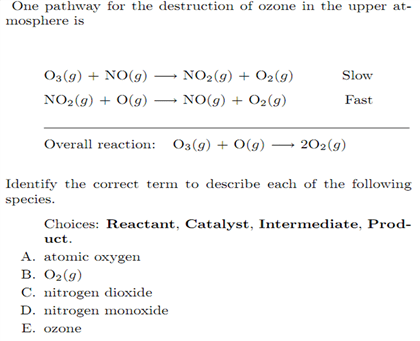1. A certain reaction has the following general form: aA â bB At a particular temperature and [A]0 = 4.00 à 10-3 M, concentration versus time data were collected for this reaction, and a plot of 1/[A] versus time result in a straight line with a slope value of +4.00 à 10-2 L/mol·s. a. Determine the differential rate law. b. Determine the integrated rate law. c. Determine the value of the reaction rate constant. d. Calculate the half-life, t½, for this reaction. e. How much time is required for the concentration of A to decrease to 1.00 à 10-3 M ?
2. One mechanism for the destruction of ozone in the upper atmosphere is: O3(g) + NO(g) â NO2(g) + O2(g) Slow NO2(g) + O(g) â NO(g) + O2(g) Fast Overall reaction: O3(g) + O(g) â 2O2(g) a. Which species is a catalyst? b. Which species is an intermediate? c. Ea for the uncatalyzed reaction O3(g) + O(g) â 2O2(g) is 14.0 kJ. Ea for the same reaction when catalyzed is 11.9 kJ. What is the ratio of the rate constant for the catalyzed reaction to that for the uncatalyzed reaction at 25 ºC? Assume that the frequency factor A is the same for each reaction.
3. Draw a rough sketch of the energy profile for each of the following cases: a. ÎE = +5 kJ/mol, Ea = 30 kJ /mol b. ÎE = -10 kJ/mol, Ea = 30 kJ /mol
4. At a given temperature, K = 1.44 à 10-2 for the reaction: N2(g) + 3H2(g) â 2NH3(g) Calculate values of K for the following reactions at the given temperature. a. 4NH3(g) â 2N2(g) + 6H2(g) b. ½N2(g) + ³â2H2(g) â NH3(g)
5. What will happen to the concentration of SO3 in equilibrium with SO2 and O2 in the reaction: 2SO3(g) â 2SO2(g) + O2(g) (ÎHº = 197 kJ) in each of the following cases? a. O2(g) is added: b. The pressure is increased by decreasing the volume of the reaction container: c. Adding Ar(g) into the reaction container: d. The temperature is decreased: e. SO2(g) is removed:
6. K = 0.090 for the reaction H2O(g) + Cl2O(g) â 2HOCl(g) at 25 ºC. Calculate the equilibrium concentrations of all species when 1.0 mol pure HOCl is placed in a 1.0-L flask.
7. Fill in the missing particles in each nuclear equation: a. Am Np _______ 237 93 241 95 ï® ï« b. e 0 -1 237 _____ï® 93Np ï« c. Np _______ He 4 2 237 93 ï® ï« d. e 0 1 275 35Br ï®_______ï« ï« e. N _______ C H 1 1 14 6 14 7 ï« ï® ï«
8. A layer of peat beneath the glacial sediments of the last ice age has a 14C/12C ratio that is 22.8% of that found in living organisms. How long ago was this ice age? (The half-life of 14C is 5730 years).
1. A certain reaction has the following general form: aA â bB At a particular temperature and [A]0 = 4.00 à 10-3 M, concentration versus time data were collected for this reaction, and a plot of 1/[A] versus time result in a straight line with a slope value of +4.00 à 10-2 L/mol·s. a. Determine the differential rate law. b. Determine the integrated rate law. c. Determine the value of the reaction rate constant. d. Calculate the half-life, t½, for this reaction. e. How much time is required for the concentration of A to decrease to 1.00 à 10-3 M ?
2. One mechanism for the destruction of ozone in the upper atmosphere is: O3(g) + NO(g) â NO2(g) + O2(g) Slow NO2(g) + O(g) â NO(g) + O2(g) Fast Overall reaction: O3(g) + O(g) â 2O2(g) a. Which species is a catalyst? b. Which species is an intermediate? c. Ea for the uncatalyzed reaction O3(g) + O(g) â 2O2(g) is 14.0 kJ. Ea for the same reaction when catalyzed is 11.9 kJ. What is the ratio of the rate constant for the catalyzed reaction to that for the uncatalyzed reaction at 25 ºC? Assume that the frequency factor A is the same for each reaction.
3. Draw a rough sketch of the energy profile for each of the following cases: a. ÎE = +5 kJ/mol, Ea = 30 kJ /mol b. ÎE = -10 kJ/mol, Ea = 30 kJ /mol
4. At a given temperature, K = 1.44 à 10-2 for the reaction: N2(g) + 3H2(g) â 2NH3(g) Calculate values of K for the following reactions at the given temperature. a. 4NH3(g) â 2N2(g) + 6H2(g) b. ½N2(g) + ³â2H2(g) â NH3(g)
5. What will happen to the concentration of SO3 in equilibrium with SO2 and O2 in the reaction: 2SO3(g) â 2SO2(g) + O2(g) (ÎHº = 197 kJ) in each of the following cases? a. O2(g) is added: b. The pressure is increased by decreasing the volume of the reaction container: c. Adding Ar(g) into the reaction container: d. The temperature is decreased: e. SO2(g) is removed:
6. K = 0.090 for the reaction H2O(g) + Cl2O(g) â 2HOCl(g) at 25 ºC. Calculate the equilibrium concentrations of all species when 1.0 mol pure HOCl is placed in a 1.0-L flask.
7. Fill in the missing particles in each nuclear equation: a. Am Np _______ 237 93 241 95 ï® ï« b. e 0 -1 237 _____ï® 93Np ï« c. Np _______ He 4 2 237 93 ï® ï« d. e 0 1 275 35Br ï®_______ï« ï« e. N _______ C H 1 1 14 6 14 7 ï« ï® ï«
8. A layer of peat beneath the glacial sediments of the last ice age has a 14C/12C ratio that is 22.8% of that found in living organisms. How long ago was this ice age? (The half-life of 14C is 5730 years).



